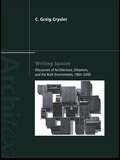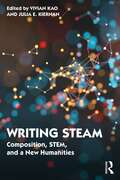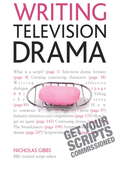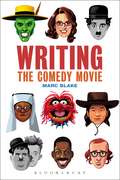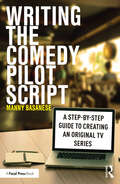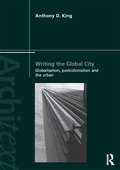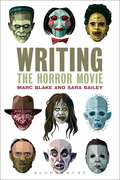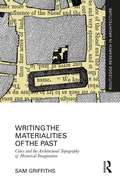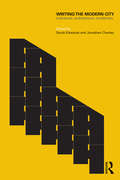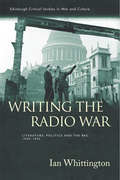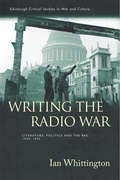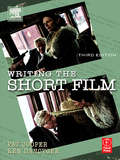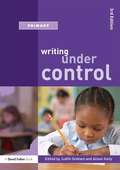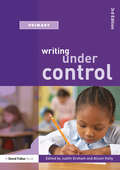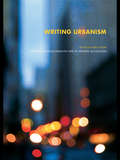- Table View
- List View
Writing Spaces: Discourses of Architecture, Urbanism and the Built Environment, 1960–2000 (Architext)
by C. Greig CryslerWriting Spaces examines some of the most important discourses in spatial theory of the last four decades, and considers their impact within the built environment disciplines. The book will be a key resource for courses on critical theory in architecture, urban studies and geography, at both the graduate and advanced undergraduate level.
Writing Spaces: Discourses of Architecture, Urbanism and the Built Environment, 1960–2000 (Architext)
by C. Greig CryslerWriting Spaces examines some of the most important discourses in spatial theory of the last four decades, and considers their impact within the built environment disciplines. The book will be a key resource for courses on critical theory in architecture, urban studies and geography, at both the graduate and advanced undergraduate level.
Writing STEAM: Composition, STEM, and a New Humanities
by Vivian KaoThis edited collection positions writing at the center of interdisciplinary higher education, and explores how writing instruction, writing scholarship, and writing program administration bring STEM and the humanities together in meaningful, creative, and beneficial ways.Writing professionals are at the forefront of a cross-pollination between STEM (Science, Technology, Engineering, and Mathematics) and the arts and humanities. In their work as educators, scholars, and administrators, they collaborate with colleagues in engineering, scientific, technical, and health disciplines, offer new degree programs that allow students to bring the humanities to bear on design experiments, and build an academic culture that promotes a vision of the humanities in the twenty-first century, as well as a vision of technology that is decidedly human. This collection surveys and promotes that work through chapters focused on writing instruction, writing scholarship, and writing program administration, covering topics that include data-driven writing courses, public science communication, non-traditional college students, creative writing, gamification, skills transfer, and Writing Across the Curriculum programs. Writing STEAM will be essential reading for scholars, instructors, and administrators in writing studies, rhetoric and composition, STEM, and a variety of interdisciplinary programs; it will aid in teacher training for both humanities and STEM courses focused on writing and communication.
Writing STEAM: Composition, STEM, and a New Humanities
by Vivian Kao Julia KiernanThis edited collection positions writing at the center of interdisciplinary higher education, and explores how writing instruction, writing scholarship, and writing program administration bring STEM and the humanities together in meaningful, creative, and beneficial ways.Writing professionals are at the forefront of a cross-pollination between STEM (Science, Technology, Engineering, and Mathematics) and the arts and humanities. In their work as educators, scholars, and administrators, they collaborate with colleagues in engineering, scientific, technical, and health disciplines, offer new degree programs that allow students to bring the humanities to bear on design experiments, and build an academic culture that promotes a vision of the humanities in the twenty-first century, as well as a vision of technology that is decidedly human. This collection surveys and promotes that work through chapters focused on writing instruction, writing scholarship, and writing program administration, covering topics that include data-driven writing courses, public science communication, non-traditional college students, creative writing, gamification, skills transfer, and Writing Across the Curriculum programs. Writing STEAM will be essential reading for scholars, instructors, and administrators in writing studies, rhetoric and composition, STEM, and a variety of interdisciplinary programs; it will aid in teacher training for both humanities and STEM courses focused on writing and communication.
Writing Television Drama: Get Your Scripts Commissioned (Teach Yourself)
by Nicholas GibbsBreak Into Writing For Television takes you from the very first line of the script through to becoming a regular writer for soaps and 'continuing dramas'. It starts with the basics of different types of script and production, and moves on to getting ideas, shaping character and dialogue, re-writing, pitching work and the practicalities of who does what in the production world, in both the UK and the US. Structured around a practical, progressive, goal-orientated approach, each chapter contains a diagnostic test, case studies, practical exercises and Aide Memoire boxes. Each chapter concludes with a reminder of the key points of the chapter (Focus Points) and a round-up of what to expect in the next (Next Step), which will whet your appetite for what's coming and how it relates to what you've just read.
Writing the Comedy Movie
by Marc BlakeIt is often suggested that there are 'secrets' to comedy or that it is 'lightning in a bottle', but the craft of comedy writing can be taught. While comedic tastes change, over time and from person to person, the core underpinning still depends on the comedic geniuses that have paved the way. Great comedy is built upon a strong foundation. In Writing the Comedy Movie, Marc Blake lays out – in an entertainingly readable style – the nuts and bolts of comedy screenwriting. His objective is to clarify the 'rules' of comedy: to contextualize comedy staples such as the double act, slapstick, gross-out, rom com, screwball, satire and parody and to introduce new ones such as the bromance or stoner comedy. He explains the underlying principles of comedy and comedy writing for the screen, along with providing analysis of leading examples of each subgenre.
Writing the Comedy Movie
by Marc BlakeIt is often suggested that there are 'secrets' to comedy or that it is 'lightning in a bottle', but the craft of comedy writing can be taught. While comedic tastes change, over time and from person to person, the core underpinning still depends on the comedic geniuses that have paved the way. Great comedy is built upon a strong foundation. In Writing the Comedy Movie, Marc Blake lays out – in an entertainingly readable style – the nuts and bolts of comedy screenwriting. His objective is to clarify the 'rules' of comedy: to contextualize comedy staples such as the double act, slapstick, gross-out, rom com, screwball, satire and parody and to introduce new ones such as the bromance or stoner comedy. He explains the underlying principles of comedy and comedy writing for the screen, along with providing analysis of leading examples of each subgenre.
Writing the Comedy Pilot Script: A Step-by-Step Guide to Creating an Original TV Series
by Manny BasaneseNavigating through the challenging process of writing a comedy pilot, this book will help screenwriters to create an original script for television. Practical and accessible, the book presents a step-by-step guide focusing on the key elements of the process. Incorporating both the history of TV comedy as well as its current evolving state in this age of the dramedy and an ever-increasing variety of broadcast and streaming platforms, the book will serve as a guide for the fledgling sitcom scribe. Author Manny Basanese breaks down the comedy pilot writing process from what may be perceived as an overwhelming, time-consuming mission into a series of much more manageable, smaller steps (from logline to outline to 1st, 2nd and polished draft). Utilizing his experience in Hollywood’s sitcom trenches, the author offers real-world advice on such topics as building the comedy pilot "world," creating memorable comic characters, sound sitcom structure, and the importance of crafting an emotional through line in a comedy pilot. Finally, there is also practical career guidance for marketing this just-completed script and breaking into the industry with advice on various topics such as the value of networking as well as gaining representation in the competitive Hollywood jungle. It is ideal for students of screenwriting and aspiring comedy screenwriters.
Writing the Comedy Pilot Script: A Step-by-Step Guide to Creating an Original TV Series
by Manny BasaneseNavigating through the challenging process of writing a comedy pilot, this book will help screenwriters to create an original script for television. Practical and accessible, the book presents a step-by-step guide focusing on the key elements of the process. Incorporating both the history of TV comedy as well as its current evolving state in this age of the dramedy and an ever-increasing variety of broadcast and streaming platforms, the book will serve as a guide for the fledgling sitcom scribe. Author Manny Basanese breaks down the comedy pilot writing process from what may be perceived as an overwhelming, time-consuming mission into a series of much more manageable, smaller steps (from logline to outline to 1st, 2nd and polished draft). Utilizing his experience in Hollywood’s sitcom trenches, the author offers real-world advice on such topics as building the comedy pilot "world," creating memorable comic characters, sound sitcom structure, and the importance of crafting an emotional through line in a comedy pilot. Finally, there is also practical career guidance for marketing this just-completed script and breaking into the industry with advice on various topics such as the value of networking as well as gaining representation in the competitive Hollywood jungle. It is ideal for students of screenwriting and aspiring comedy screenwriters.
Writing the Global City: Globalisation, Postcolonialism and the Urban (Architext)
by Anthony D KingOver the last three decades, our understanding of the city worldwide has been revolutionized by three innovative theoretical concepts – globalisation, postcolonialism and a radically contested notion of modernity. The idea and even the reality of the city has been extended out of the state and nation and re-positioned in the larger global world. In this book Anthony King brings together key essays written over this period, much of it dominated by debates about the world or global city. Challenging assumptions and silences behind these debates, King provides largely ignored historical and cultural dimensions to the understanding of world city formation as well as decline. Interdisciplinary and comparative, the essays address new ways of framing contemporary themes: the imperial and colonial origin of contemporary world and global cities, actually existing postcolonialisms, claims about urban and cultural homogenisation and the role of architecture and built environment in that process. Also addressed are arguments about indigenous and exogenous perspectives, Eurocentricism, ways of framing vernacular architecture, and the global historical sociology of building types. Wide-ranging and accessible, Writing the Global City provides essential historical contexts and theoretical frameworks for understanding contemporary urban and architectural debates. Extensive bibliographies will make it essential for teaching, reference and research.
Writing the Global City: Globalisation, Postcolonialism and the Urban (Architext)
by Anthony D KingOver the last three decades, our understanding of the city worldwide has been revolutionized by three innovative theoretical concepts – globalisation, postcolonialism and a radically contested notion of modernity. The idea and even the reality of the city has been extended out of the state and nation and re-positioned in the larger global world. In this book Anthony King brings together key essays written over this period, much of it dominated by debates about the world or global city. Challenging assumptions and silences behind these debates, King provides largely ignored historical and cultural dimensions to the understanding of world city formation as well as decline. Interdisciplinary and comparative, the essays address new ways of framing contemporary themes: the imperial and colonial origin of contemporary world and global cities, actually existing postcolonialisms, claims about urban and cultural homogenisation and the role of architecture and built environment in that process. Also addressed are arguments about indigenous and exogenous perspectives, Eurocentricism, ways of framing vernacular architecture, and the global historical sociology of building types. Wide-ranging and accessible, Writing the Global City provides essential historical contexts and theoretical frameworks for understanding contemporary urban and architectural debates. Extensive bibliographies will make it essential for teaching, reference and research.
Writing the Horror Movie
by Marc Blake Sara BaileyTales of horror have always been with us, from Biblical times to the Gothic novel to successful modern day authors and screenwriters. Though the genre is often maligned, it is huge in popularity and its resilience is undeniable. Marc Blake and Sara Bailey offer a detailed analysis of the horror genre, including its subgenres, tropes and the specific requirements of the horror screenplay.Tracing the development of the horror film from its beginnings in German Expressionism, the authors engage in a readable style that will appeal to anyone with a genuine interest in the form and the mechanics of the genre. This book examines the success of Universal Studio's franchises of the '30s to the Serial Killer, the Slasher film, Asian Horror, the Supernatural, Horror Vérité and current developments in the field, including 3D and remakes. It also includes step-by-step writing exercises, annotated extracts from horror screenplays and interviews with seasoned writers/directors/ producers discussing budget restrictions, screenplay form and formulas and how screenplays work during shooting.
Writing the Horror Movie
by Marc Blake Sara BaileyTales of horror have always been with us, from Biblical times to the Gothic novel to successful modern day authors and screenwriters. Though the genre is often maligned, it is huge in popularity and its resilience is undeniable. Marc Blake and Sara Bailey offer a detailed analysis of the horror genre, including its subgenres, tropes and the specific requirements of the horror screenplay.Tracing the development of the horror film from its beginnings in German Expressionism, the authors engage in a readable style that will appeal to anyone with a genuine interest in the form and the mechanics of the genre. This book examines the success of Universal Studio's franchises of the '30s to the Serial Killer, the Slasher film, Asian Horror, the Supernatural, Horror Vérité and current developments in the field, including 3D and remakes. It also includes step-by-step writing exercises, annotated extracts from horror screenplays and interviews with seasoned writers/directors/ producers discussing budget restrictions, screenplay form and formulas and how screenplays work during shooting.
Writing the Materialities of the Past: Cities and the Architectural Topography of Historical Imagination (Routledge Research in Architecture)
by Sam GriffithsWriting the Materialities of the Past offers a close analysis of how the materiality of the built environment has been repressed in historical thinking since the 1950s. Author Sam Griffiths argues that the social theory of cities in this period was characterised by the dominance of socio-economic and linguistic-cultural models, which served to impede our understanding of time-space relationality towards historical events and their narration. The book engages with studies of historical writing to discuss materiality in the built environment as a form of literary practice to express marginalised dimensions of social experience in a range of historical contexts. It then moves on to reflect on England’s nineteenth-century industrialization from an architectural topographical perspective, challenging theories of space and architecture to examine the complex role of industrial cities in mediating social changes in the practice of everyday life. By demonstrating how the authenticity of historical accounts rests on materially emplaced narratives, Griffiths makes the case for the emancipatory possibilities of historical writing. He calls for a re-evaluation of historical epistemology as a primarily socio-scientific or literary enquiry and instead proposes a specifically architectural time-space figuration of historical events to rethink and refresh the relationship of the urban past to its present and future. Written for postgraduate students, researchers and academics in architectural theory and urban studies, Griffiths draws on the space syntax tradition of research to explore how contingencies of movement and encounter construct the historical imagination.
Writing the Materialities of the Past: Cities and the Architectural Topography of Historical Imagination (Routledge Research in Architecture)
by Sam GriffithsWriting the Materialities of the Past offers a close analysis of how the materiality of the built environment has been repressed in historical thinking since the 1950s. Author Sam Griffiths argues that the social theory of cities in this period was characterised by the dominance of socio-economic and linguistic-cultural models, which served to impede our understanding of time-space relationality towards historical events and their narration. The book engages with studies of historical writing to discuss materiality in the built environment as a form of literary practice to express marginalised dimensions of social experience in a range of historical contexts. It then moves on to reflect on England’s nineteenth-century industrialization from an architectural topographical perspective, challenging theories of space and architecture to examine the complex role of industrial cities in mediating social changes in the practice of everyday life. By demonstrating how the authenticity of historical accounts rests on materially emplaced narratives, Griffiths makes the case for the emancipatory possibilities of historical writing. He calls for a re-evaluation of historical epistemology as a primarily socio-scientific or literary enquiry and instead proposes a specifically architectural time-space figuration of historical events to rethink and refresh the relationship of the urban past to its present and future. Written for postgraduate students, researchers and academics in architectural theory and urban studies, Griffiths draws on the space syntax tradition of research to explore how contingencies of movement and encounter construct the historical imagination.
Writing the Modern City: Literature, Architecture, Modernity
by Sarah Edwards Jonathan CharleyLiterary texts and buildings have always represented space, narrated cultural and political values, and functioned as sites of personal and collective identity. In the twentieth century, new forms of narrative have represented cultural modernity, political idealism and architectural innovation. Writing the Modern City explores the diverse and fascinating relationships between literature, architecture and modernity and considers how they have shaped the world today. This collection of thirteen original essays examines the ways in which literature and architecture have shaped a range of recognisably ‘modern’ identities. It focuses on the cultural connections between prose narratives – the novel, short stories, autobiography, crime and science fiction – and a range of urban environments, from the city apartment and river to the colonial house and the utopian city. It explores how the themes of memory, nation and identity have been represented in both literary and architectural works in the aftermath of early twentieth-century conflict; how the cultural movements of modernism and postmodernism have affected notions of canonicity and genre in the creation of books and buildings; and how and why literary and architectural narratives are influenced by each other’s formal properties and styles. The book breaks new ground in its exclusive focus on modern narrative and urban space. The essays examine texts and spaces that have both unsettled traditional definitions of literature and architecture and reflected and shaped modern identities: sexual, domestic, professional and national. It is essential reading for students and researchers of literature, cultural studies, cultural geography, art history and architectural history.
Writing the Modern City: Literature, Architecture, Modernity
by Sarah Edwards Jonathan CharleyLiterary texts and buildings have always represented space, narrated cultural and political values, and functioned as sites of personal and collective identity. In the twentieth century, new forms of narrative have represented cultural modernity, political idealism and architectural innovation. Writing the Modern City explores the diverse and fascinating relationships between literature, architecture and modernity and considers how they have shaped the world today. This collection of thirteen original essays examines the ways in which literature and architecture have shaped a range of recognisably ‘modern’ identities. It focuses on the cultural connections between prose narratives – the novel, short stories, autobiography, crime and science fiction – and a range of urban environments, from the city apartment and river to the colonial house and the utopian city. It explores how the themes of memory, nation and identity have been represented in both literary and architectural works in the aftermath of early twentieth-century conflict; how the cultural movements of modernism and postmodernism have affected notions of canonicity and genre in the creation of books and buildings; and how and why literary and architectural narratives are influenced by each other’s formal properties and styles. The book breaks new ground in its exclusive focus on modern narrative and urban space. The essays examine texts and spaces that have both unsettled traditional definitions of literature and architecture and reflected and shaped modern identities: sexual, domestic, professional and national. It is essential reading for students and researchers of literature, cultural studies, cultural geography, art history and architectural history.
Writing the Radio War: Literature, Politics, and the BBC, 1939-1945 (Edinburgh Critical Studies In War And Culture Ser.)
by Ian WhittingtonAn interdisciplinary study of one of the most important monuments in Islamic art
Writing the Radio War: Literature, Politics, and the BBC, 1939-1945
by Ian WhittingtonThe most extensive examination yet of control across disciplines and cultural modes of expression – showing that control is the cultural logic of the 21st century
Writing the Short Film
by Patricia Cooper Ken DancygerThe short film is a unique narrative art form that, while lending itself to experimentation, requires tremendous discipline in following traditional filmic considerations. This book takes the student and novice screenwriter through the storytelling process- from conception, to visualization, to dramatization, to characterization and dialogue- and teaches them how to create a dramatic narrative that is at once short (approximately half an hour in length) and complete. Exercises, new examples of short screenplays, and an examination of various genres round out the discussion.NEW TO THE THIRD EDITION: new screenplays, a chapter on rewriting your script, and a chapter on the future of short films
Writing the Short Film
by Patricia Cooper Ken DancygerThe short film is a unique narrative art form that, while lending itself to experimentation, requires tremendous discipline in following traditional filmic considerations. This book takes the student and novice screenwriter through the storytelling process- from conception, to visualization, to dramatization, to characterization and dialogue- and teaches them how to create a dramatic narrative that is at once short (approximately half an hour in length) and complete. Exercises, new examples of short screenplays, and an examination of various genres round out the discussion.NEW TO THE THIRD EDITION: new screenplays, a chapter on rewriting your script, and a chapter on the future of short films
Writing Under Control
by Judith Graham Alison KellyNow in its third edition and reflecting changes in the Primary National Strategy, this best-selling textbook introduces primary teachers to key issues in the teaching of writing. Strongly rooted in classroom practice, the book includes: the history, theory and practice of teaching writing children writing in and out of school EAL and gender issues in writing the development of writing across the years of the primary school planning classroom routines and organising resources balancing the composition and transcription elements in writing monitoring and assessing writing meeting individual needs managing specific learning difficulties in writing, such as dyslexia With its companion Reading under Control (also in its third edition), this book provides undergraduate and postgraduate teachers with comprehensive guidance for the teaching of literacy.
Writing Under Control
by Judith Graham Alison KellyNow in its third edition and reflecting changes in the Primary National Strategy, this best-selling textbook introduces primary teachers to key issues in the teaching of writing. Strongly rooted in classroom practice, the book includes: the history, theory and practice of teaching writing children writing in and out of school EAL and gender issues in writing the development of writing across the years of the primary school planning classroom routines and organising resources balancing the composition and transcription elements in writing monitoring and assessing writing meeting individual needs managing specific learning difficulties in writing, such as dyslexia With its companion Reading under Control (also in its third edition), this book provides undergraduate and postgraduate teachers with comprehensive guidance for the teaching of literacy.
Writing Urbanism: A Design Reader (The ACSA Architectural Education Series)
by Douglas Kelbaugh Kit McCulloughUrban design continues to grow as an increasingly important and expanding field of study, research and professional endeavour. Distinguished by its broad scope and comprehensiveness on the subject of urban design, this new collection combines selected essays from both practitioners and academia. Writing Urbanism is the ideal volume for both students, architects and urban designers.
Writing Urbanism: A Design Reader (The ACSA Architectural Education Series)
by Douglas Kelbaugh Kit McCulloughUrban design continues to grow as an increasingly important and expanding field of study, research and professional endeavour. Distinguished by its broad scope and comprehensiveness on the subject of urban design, this new collection combines selected essays from both practitioners and academia. Writing Urbanism is the ideal volume for both students, architects and urban designers.
